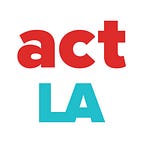Infrastructure that Uplifts: Affordable Housing Near Transit is a Win-Win
The tower of apartments above the Vermont/Wilshire Metro stop in Koreatown is accompanied by an expansive parking garage right next to the subway entrance. Studios there go for at least $1800 a month and a one bedroom at least $2100. Just the other day I was walking by the garage to access the Red Line and paused for a BMW to go in and a Lexus to leave.
Unfortunately, this is par for the course; much of the new housing being built near transit is for high income earners, who are the least likely to make use of the system. In fact, the median household income of LA’s public transit riders hovers around $16,000 a year and over 90% of riders are people of color. As taxpayers in LA County invest over $160 billion in the system during a severe housing affordability crisis, are we really going to continue developing expensive housing and parking for luxury cars around the stops?
A new effort at our regional transportation agency, Metro, aims to tackle this frustrating mismatch. On June 28, Metro’s Board will be considering a first-of-its-kind Transit Oriented Communities (TOC) policy, a new blueprint for how a transit agency and jurisdictions receiving new investment can maximize affordable housing and anti-displacement policies around major transit stops to help Metro’s core transit riders live nearby. And the benefits would not stop at housing; equitable development near stations could bring high road career paths to struggling communities and boost support for mom and pop businesses hit hard by gentrification.
It is commendable for Metro to set forth such a vision but there really isn’t much of a choice. While there are many reasons transit ridership in the region is dropping despite billions in investment, the out migration of low-income people of color from the region has got to be factored in. It is a cruel irony that LA Metro’s massive investments threaten the very communities that depend on public transit the most. Low-income tenants and long-time businesses near stations are being pushed out as land becomes more valuable and gentrification spurs high-end development.
Given that each local city has land use authority and that Metro has the “power of the purse,” this needs to be tackled by both the agency and cities. Cities with new transit projects must adopt strong tenant protections policies first and foremost to avoid displacement, and must have strong affordable housing and labor requirements paired with any density increases and fewer parking requirements near transit. And Metro can expand and deepen its commitment to acquiring land near transit stops and building housing affordable to transit riders on Metro-owned land.
The good news is, we have excellent models that we can scale up. The City of Los Angeles has recently started implementing its Transit Oriented Communities Affordable Housing Incentive Program, which voters passed via Measure JJJ in 2016. In the first six months of the program, dozens of projects were proposed under the program, and LA’s Department of Public Health estimated that this will eventually bring thousands of low, very low and extremely low-income units right near transit stops. These efforts must be scaled up throughout the whole County.
Communities of color continue to suffer LA’s history of discriminatory transit and land use planning. LA now has a golden opportunity to chart a new direction. No other region has this scale of resources at its disposal to tackle the commuting and housing struggles afflicting residents. Metro’s new TOC policy could be a start but needs real commitment from the agency and city leaders around the region.
Laura Raymond is the Director of the Alliance for Community Transit — Los Angeles (ACT-LA), a coalition of 35 community-based organizations in Los Angeles.
